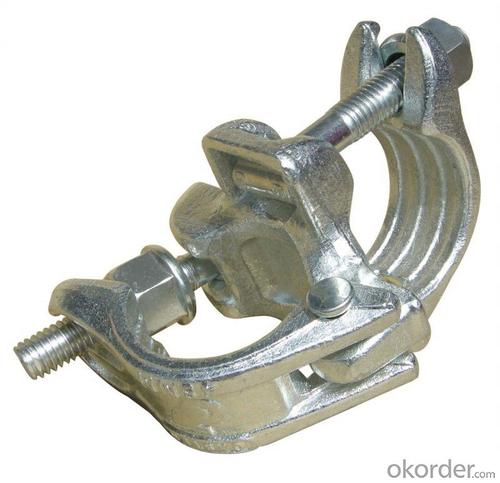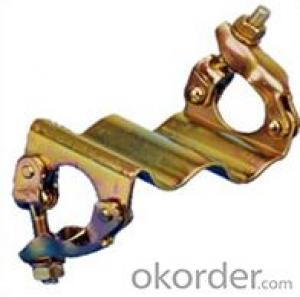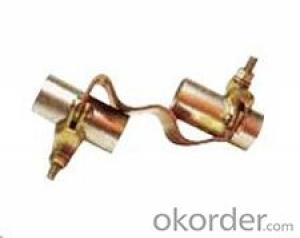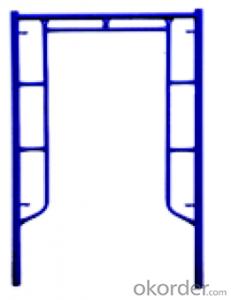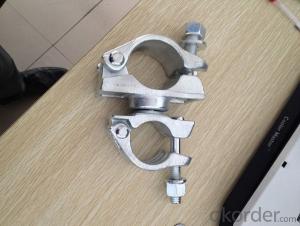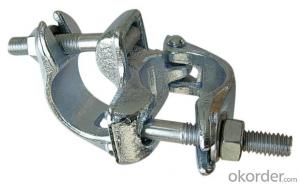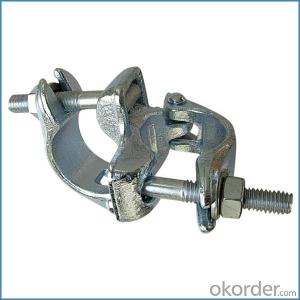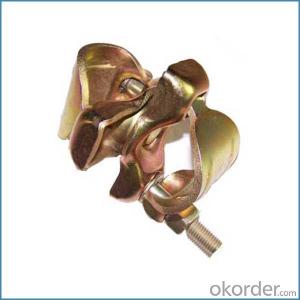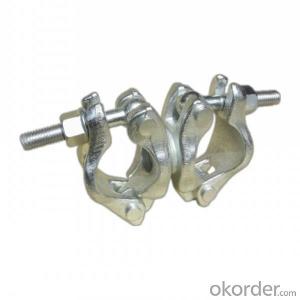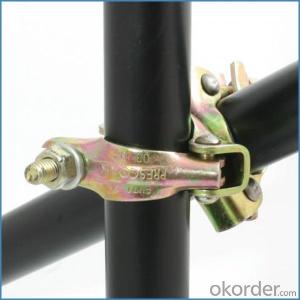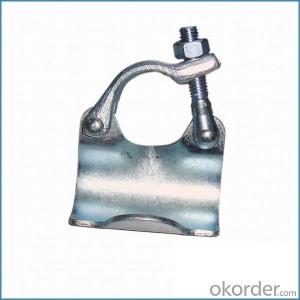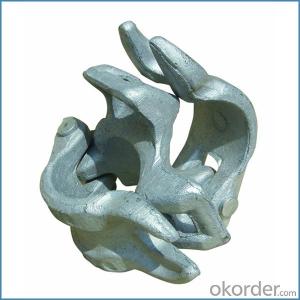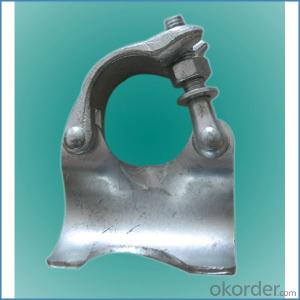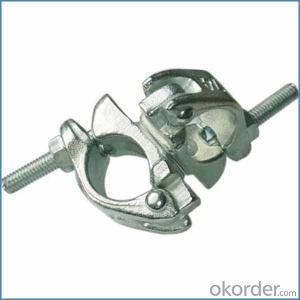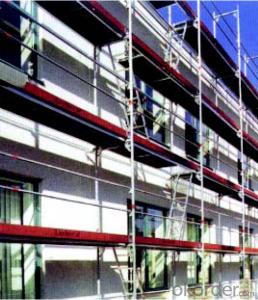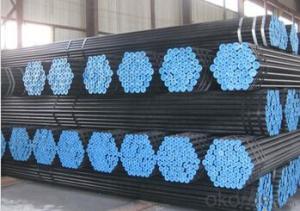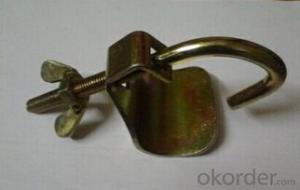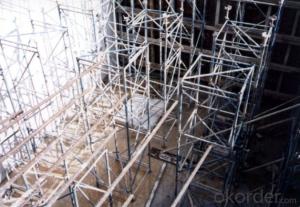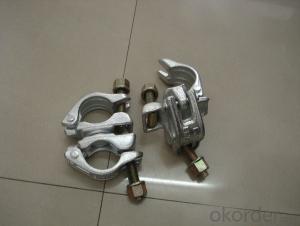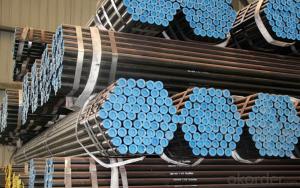Galvanized Scaffold Clamp British German Forged Type
- Loading Port:
- Tianjin
- Payment Terms:
- TT OR LC
- Min Order Qty:
- 1000 kg
- Supply Capability:
- 100000 kg/month
OKorder Service Pledge
OKorder Financial Service
You Might Also Like
Galvanized Scaffold Clamp British German Forged Type
Description
1.The scaffolding coupler is always used to connect the steel pipe as scaffolding system.
2.The often used coupler is swivel coupler and righ angle coupler .
3.We can provide types of scaffolding coupler according to your requirement.
4.Couoler can fix the 48.3mm scaffolding steel pipe tightly and make the whole scaffolding system more steadily.
Feature
(1)Excellent Anti-Breaking—Cold Pressed Steel
(2)Outstanding Resistance Deformation
(3)Strong Anti-Dropping Ability
Photo
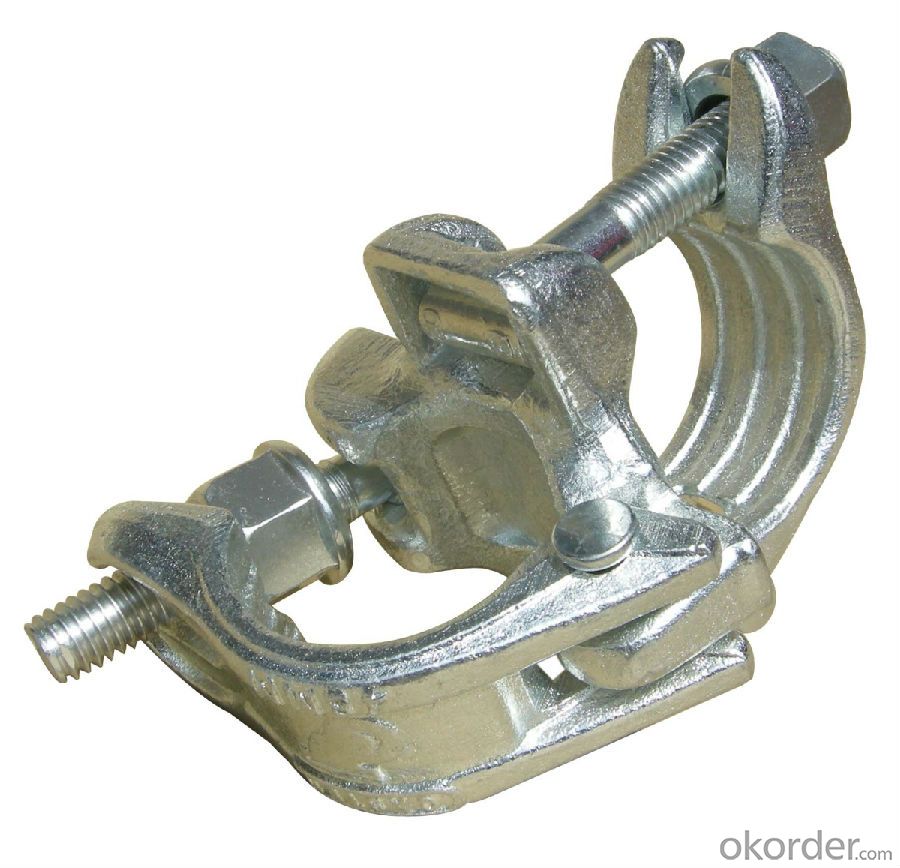
Parameter
| Material | Q235,345steel |
| Size | 48.3mm*48.3mm |
| Surface finish | Galvanized |
| Weight | 1.1kg around |
| Standard | BS1139,EN74 |
| Package | 25pcs/bag,steel pallet |
| Manufacture | As per customer requirement |
| Market | Africa, South America, the Middle East and Asia |
FAQ
Q: Are you a factory or trading company?
We are a state-owned corporation in China,dealing with various kinds of building materials.We have our holding subsidiaries.
Q: Where is your factory located? How can I visit there?
Our factory is located all around China.
Q: Can I get some samples?
Sample is free, customer only pay freight for the first time.
Q: Delivery?
10-30days. (5-15 containers)
Any question,feel free to contact us.
- Q: Can steel tube couplers be used in scaffolding that requires specialized or custom connections?
- Steel tube couplers can be used in scaffolding that requires specialized or custom connections to some extent. However, it is important to note that steel tube couplers are generally designed for standard connections and may not always be suitable for complex or highly specialized scaffolding requirements. Steel tube couplers are commonly used in scaffolding systems due to their versatility and ease of use. They allow for quick and secure connections between steel tubes, providing stability and strength to the scaffolding structure. They are typically used for standard connections such as right angles, swivel connections, and straight connections. However, when it comes to specialized or custom connections in scaffolding, steel tube couplers may not always be the ideal solution. These connections often require specific design considerations, such as unique angles, non-standard joint configurations, or specialized load-bearing requirements. In such cases, it may be necessary to use other types of scaffolding connectors or components that are specifically designed for these specialized connections. It is important to consult with scaffold design professionals or engineers who have expertise in specialized scaffolding requirements. They can assess the project's needs and recommend the appropriate connectors or components that can meet the specific requirements and ensure the safety and stability of the scaffolding structure. In summary, while steel tube couplers are versatile and widely used in scaffolding, they may not always be suitable for specialized or custom connections. It is essential to consult with experts and use appropriate connectors or components that are specifically designed for these requirements to ensure the safety and stability of the scaffolding structure.
- Q: Can steel tube couplers be used in scaffolding projects with limited foundation support?
- Yes, steel tube couplers can be used in scaffolding projects with limited foundation support. Steel tube couplers are designed to securely connect steel tubes together, providing a strong and stable structure. However, it is important to ensure that the scaffolding system is properly designed and engineered to accommodate the limited foundation support, taking into consideration factors such as load capacity and stability. It is recommended to consult with a structural engineer or scaffolding expert to assess the feasibility and safety of using steel tube couplers in such projects.
- Q: Are there any specific guidelines for the proper installation and tightening of steel tube couplers?
- Yes, there are specific guidelines for the proper installation and tightening of steel tube couplers. These guidelines usually include instructions on preparing the surface, aligning the couplers, ensuring a proper fit, and using the appropriate tools for tightening. It is important to follow these guidelines to ensure the integrity and safety of the connection.
- Q: What is the maximum load capacity of steel tube couplers?
- The maximum load capacity of steel tube couplers varies depending on various factors such as the specific type of coupler, its design, size, and the grade of steel used in its construction. Generally, steel tube couplers are designed to withstand heavy loads and are commonly used in construction and scaffolding applications. The load capacity of a steel tube coupler is typically specified by manufacturers and can range from a few hundred kilograms to several tonnes. It is important to consult the manufacturer's specifications and guidelines to determine the maximum load capacity of a specific steel tube coupler before using it in any application. Additionally, factors such as proper installation, proper use of safety measures, and adherence to load limits are crucial in ensuring the safe and effective use of steel tube couplers.
- Q: What are the typical material specifications for steel tube couplers used in scaffolding?
- The typical material specifications for steel tube couplers used in scaffolding are usually made of high-quality steel, with a minimum tensile strength of 350 MPa and a minimum yield strength of 235 MPa. They are typically galvanized to provide corrosion resistance and have a standard diameter of 48.3 mm to fit standard scaffolding tubes. Additionally, they should comply with relevant industry standards and regulations, such as EN 74 and ANSI/SSFI SC100-5/05.
- Q: I have looked for months with no luck.
- Try any industrial supply stores as listed on the web or in industrial supply catalogs.
- Q: Can steel tube couplers be used with other types of scaffolding couplers?
- It is not possible to use steel tube couplers in conjunction with other types of scaffolding couplers. Steel tube couplers have been specifically engineered to securely connect steel tubes in scaffolding systems. They are not compatible with pressed steel couplers or putlog couplers, which are intended for different purposes and employ distinct connection mechanisms. To guarantee the safety and stability of the scaffolding structure, it is crucial to employ the appropriate type of scaffolding coupler for the particular application.
- Q: What are the requirements for inspecting steel tube couplers in scaffolding?
- Inspecting steel tube couplers in scaffolding involves a comprehensive examination to guarantee their safety and stability. Several key requirements include: 1. Visual Inspection: Inspectors must visually assess each steel tube coupler for visible damage or signs of wear and tear. This entails checking for cracks, deformations, rust, or any indications of structural compromise. 2. Verification of Load Capacity: Inspectors are responsible for ensuring that the steel tube couplers can safely support the intended load. This may involve verifying the couplers' load capacity and cross-referencing it with the weight of the scaffolding components and equipment to be used. 3. Proper Fit and Alignment: Inspectors should confirm that the steel tube couplers fit securely onto the scaffolding tubes and are properly aligned. Any loose or misaligned couplers should be identified and rectified to ensure a secure connection. 4. Labeling and Identification: It is crucial to ensure that all steel tube couplers are appropriately labeled and identified, indicating their load capacity, manufacturer, and any specific instructions or limitations. Inspectors should ensure that the labeling is clear and legible. 5. Regular Maintenance and Inspections: In addition to initial inspections, regular maintenance and periodic inspections should be conducted to ensure ongoing safety and performance. Inspectors should establish a maintenance schedule and ensure that all steel tube couplers are inspected and maintained according to the manufacturer's recommendations. 6. Compliance with Relevant Standards: Inspectors must verify that the steel tube couplers comply with relevant industry standards and regulations, such as those set by the Occupational Safety and Health Administration (OSHA) or local building codes. Compliance with these standards ensures that the couplers meet minimum safety requirements. Overall, the inspection requirements for steel tube couplers in scaffolding aim to guarantee the structural integrity, load capacity, and overall safety of the scaffolding system. By conducting thorough inspections and adhering to these requirements, potential hazards or risks associated with faulty or compromised couplers can be minimized, promoting a safe working environment.
- Q: Can steel tube couplers be used in scaffolding projects with uneven loads?
- Steel tube couplers can be used in scaffolding projects with uneven loads, as they are designed to provide a secure and strong connection between tubes. However, it is important to ensure that the scaffolding structure is properly designed and braced to handle the uneven loads. Additionally, regular inspections and maintenance should be conducted to ensure the couplers and scaffolding system remain in good condition and can safely support the loads.
- Q: Ive had it in a week today and it is still sore. And when i take it out theres a mark where the bar is pressed against my ear. Does it look okay?
- It looks like dried blood to me. Make sure you clean it at least twice a day with warm water and sea salt. I would go back to the shop that pierced it to see what theey say about it. Your industrial will be sore for a while. I waited six months to take my bar out and it was still kind of sore. One tip I can give is to use a spray bottle for your warm water and salt water. Its easy to make sure your really cleaning your piercing! Good luck!
Send your message to us
Galvanized Scaffold Clamp British German Forged Type
- Loading Port:
- Tianjin
- Payment Terms:
- TT OR LC
- Min Order Qty:
- 1000 kg
- Supply Capability:
- 100000 kg/month
OKorder Service Pledge
OKorder Financial Service
Similar products
Hot products
Hot Searches
Related keywords


